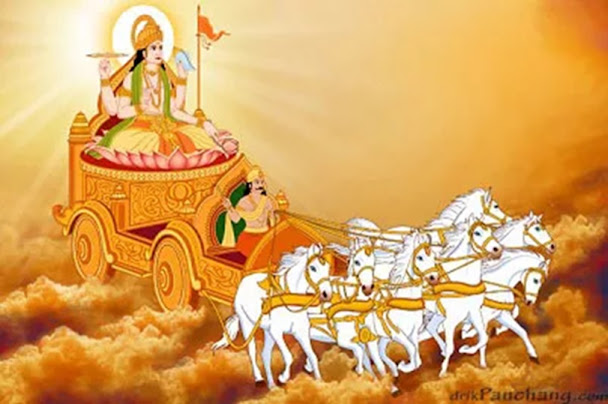07 – 02 – 2022 – Surya Jayanti – Birthday of Sun God – RATHA SAPTAMI
Ratha means chariot and Saptami means seven. Thus Ratha Saptami means Sun God in his chariot moves on the 7th Day of Saptami tithi in the month of Magha during the Shukla Paksha towards the northern hemisphere.
This day signifies the arrival of summer season and is
also indicative of the beginning of the harvesting season. Thus for farmers,
the day symbolizes the dawn of Prosperity, Happiness and Health.
Ratha Saptami is also called by various names such as
Magha Saptami, Magha Jayanti, Aroghya Saptami etc.
On the day of Ratha Saptami, devotees get up before sunrise called Arunodaya (Dawn) to take a holy bath. The Ratha Saptami bath is an important ritual of the day and should be performed at the time of ‘Arunodaya’ (Dawn) only. It is believed that by taking a sacred bath during this time, will free a person from all illnesses and ailments and bestow good health. For this reason Ratha Saptami is also popularly known as ‘Arogya Saptami’. In Tamil Nadu, devotees take this sacred bath using Erukku leaves.
After completing the bath, devotees offer ‘Arghyadan’
to Sun God at the time of sunrise.
The rite of ‘Arghyadan’ is performed by offering water
slowly from a small kalash in Namaskar Mudra to Surya Bhagwan by facing towards
Him in the standing position.
Many people perform this ritual 12 times along with
chanting twelve different names of Surya Bhagwan, each time.
Following this, devotee light up a Ghee Deepak and
worship Sun God with red flowers. It is believed that the observer of all these
rituals to Sun God will be bestowed with good health, longevity and success.
According to the legends, it is believed that by
making donations on the eve of this occasion, the devotees get rid of their
sins and illness and are also bestowed
with longevity, prosperity and good health.
Chanting ‘Gayatri Mantra’ and reciting ‘Surya
Sahasranaam’, ‘Adityahridayam’ or ‘Suryashtakam’ are considered very auspicious
on this day.
Sun God’s Chariot drawn by 7 horses has Aruna as his
charioteer who was born prematurely resulting in having no legs at his birth
due to his mother’s impatience.
According to the epic Mahabharata, Sage Kashyapa’s two
wives Vinata and Kadru wanted to have children and he granted them a boon.
Kadru asked for one thousand Nāga (serpent) sons, while Vinata wanted two human
sons. Kashyapa blessed them, and then went away to a forest. Later, Kadru gave
birth to one thousand eggs, while Vinata gave birth to two eggs. These
incubated for five hundred years, upon which Kadru broke the eggs open and out
came her 1,000 sons. Vinata eager for her sons, broke one of the eggs from
which emerged the partially formed Aruna. From the broken egg a flash of light,
Aruna, sprang forth. He was as radiant and reddish as the morning sun. But, due
to the premature breaking of the egg, Aruna was not as bright as the noon sun
as he was promised to be.
Since Aruna was born prematurely, his body was partially developed and had no legs. Enraged by the haste of his mother, he cursed her that she will become the slave of Kadru for 500 years and added that when the second egg will break, his son will redeem her. Having cursed his mother, Aruna flew into the sky. Accordingly, Vinata waited, and later the fully developed brother of Aruna named Garuda (vehicle of Vishnu) was born.
Another narration in the epic states that Surya
angered by the attacks of Rahu (who swallowed Surya causing solar eclipses) had
started to burn intensely thereby destroying all living beings. The god Brahma
asked Aruna to become the charioteer of Surya to move around the world to
shelter all beings from Surya's burning heat. Hence we have rising, morning,
noon and setting suns having different temperatures which are healthy and
helpful to all creatures in the world.
Aruna literally means "red, ruddy, and tawny"
and is the personification of the reddish glow of the rising Sun.
Aruna is also found in Buddhism and Jainism literature
and arts.
Wat Arun in Thailand derives its name from Aruna. His
children was Sampati and Jatayu.
The seven horses of Sun’s chariot are the seven
colours radiating through the White
Light – VIBGYOR – Violet, Indigo, Blue, Green, Yellow, Orange, Red.
The seven horses of Sun’s Chariot also represent 7
days in a week.
The seven horses are named after the seven meters of
Sanskrit prosody: Gayatri, Brihati, Ushnih, Jagati, Trishtubha, Anushtubha and
Pankti.
Further seven horses representing seven colours or
rays are considered to depict seven virtues. The seven virtues are Will Power,
Wisdom, Sincerity, Harmony, Perseverance, Devotion and Courage.
Sun is the life giving energy in the world for all
creatures. Worshipping Sun God by chanting Gayathri Mantra from Rig Veda
becomes important to all Hindus. Meaning of Gayathri Mantra: “We meditate on
the effulgent glory of the divine Light of the Sun; may he inspire our
understanding.“
LET US ALL BE
BLESSED BY SUN GOD ON HIS JAYANTI.
WAT ARUN – A BUDDHIST TEMPLE IN BANGKOK, THAILAND





Comments